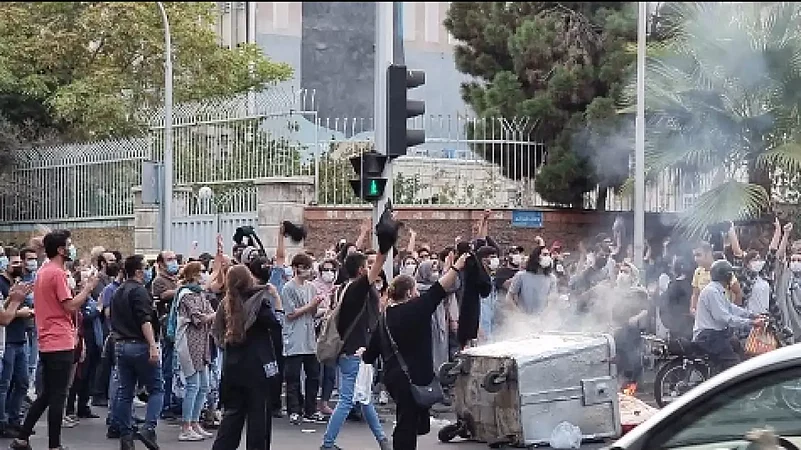Iran has been a diplomatic dilemma for India since?2018 when the United States?withdrew?from the nuclear deal — formally called the Joint Comprehensive Programme of Cooperation (JCPOA), signed in 2015 by the five permanent members of the United Nations (UN) Security Council and Germany. US sanctions that followed curtailed India’s oil imports from Iran and hobbled bilateral trade.?
How Iran Uprising Is More Complex Than Earlier Protests, Why Iran Is A Diplomatic Dilemma For India
India avoids a public position on Iran’s internal travails and abstains at the UN resolution condemning Iran while maintaining bilateral engagement with it. In the wake of US sanctions, India chose a middle path between not offending the United States and maintaining some normalcy in India-Iran relations.

India chose a middle path between not offending the United States and maintaining some normalcy in India-Iran relations. Despite President Donald Trump losing to Joe Biden in 2020 elections, the United States has struggled to resurrect the deal that President Barak Obama negotiated towards the end of his presidency.?
The US-Iran relations got complicated by the Iranian protests over the enforcement of hijab —hair-covering— by the Iranian morality police on women. Death of a Kurdish woman detainee, Mahsa Amini, on September 16 inflamed the uprising. Two months later, the Iranian authorities have failed to control the situation. Over 350 persons are reported killed, including nearly 50 children. New book White Torture by Narges Mohammadi narrates the horrifying testimonies of 14 brutalised women detained at the notorious Evin prison in Teheran.
Iran has a history of popular protests that weakened or even overthrew regimes. In the 19th century, huge protests, often led by women, against the ruling Qajar dynasty would begin and then intrude into the compounds of British or Russian embassies for sanctuary or “Bast”. The present Islamic regime came to power through street protests that gradually overpowered the Shah’s security forces. So far, Iran has avoided using massive force, perhaps fearing it may boomerang like in Shah’s case.
The Iranian Revolutionary Guards Corps (IRGC) and their associate the Basij controlled the anti-regime protests in 2009, over alleged rigged re-election of incumbent president Mahmoud Ahmadinejad, and the gas price rise protests in 2019. The present upsurge is more widespread and complex.?
Firstly, it follows economic distress due to US and Western sanctions since 2018 and subsequent disarray by Covid-19 pandemic. Global inflation also complicates economic handling. Secondly, the patriarchal discrimination against women has been an irritant since the Islamic Revolution of 1979. The female angst has combined with general discontentment cutting across Iran’s ethnic, religious, economic and gender divisions. Iranian Nobel laureate and activist-lawyer Shirin Abedi calls it a fight against “theocratic tyranny”. The people appear unwilling to settle for token relaxation of Islamic rules on female head-cover or dress. They are seeking regime change.
Iran’s geopolitical environment has mutated since the Iranian influence peaked, in the aftermath of the overthrowal of Iraqi President Saddam Hussein in 2003, with the JCPOA. The United States began rebalancing its relations in the Gulf by engaging Iran, despite its traditional allies like Saudi Arabia and United Arab Emirates (UAE) feeling insecure. Trump reversed this strategy, eventually leading to the Abraham Accords.?
The Abraham Accords created a fresh anti-Iran front of Israel and some Gulf nations like UAE and Bahrain. The Ukraine War since February 2022 further reconfigured regional power balance, with Iran moving into the China-Russia corner. Consequently, the United States now openly supports the protestors, unlike during earlier protests. Iranian drones in Russian armoury exacerbate the bloodletting in Ukraine.
Simultaneously, Iranian influence in the so-called Shia-crescent, running through Iraq, Syria, and Lebanon, is waning. Hezbollah allowed the United States to settle the Lebanon-Israel maritime boundary. Assad regime in Syria is reaching out to Sunni Arab powers in the Gulf. Former reformist Iranian President Muhammed Khatami has remerged in Iranian media after years of exile. Iran has stepped-up its nuclear enrichment in violation of past commitments in JCPOA and the International Atomic Energy Commission (IAEA). The nation is clearly at an inflexion point as its aging and ailing Supreme Leader Ali Khamenei finds his handpicked president Ebrahim Raisi ineffective as interlocutor due to tainted past as the regime’s hangman-as-judge.
India hosted Iranian Deputy Foreign Minister Ali Bagheri Kani on November 24 for talks. He is Supreme Leader’s relative and leads Iran’s nuclear parleys. India avoids defying sanctions on Iran, unlike in Russia’s case. The United States has sanctioned an Indian company Tibalaji Petrochemicals for Iranian oil trade. India desires to invest in Shahid Behesti Terminal at Chahbahar port, outside the Gulf. But its utility is limited until the Taliban controls Afghanistan and Russia remains preoccupied with Ukraine. Bilateral trade remains constrained by Iran’s economic limitations. China has used the vacuum to become the principal trading partner of Iran. By hosting 19 nations for an Indian Ocean conference, while ignoring India, China displayed its maritime strategy.
India avoids a public position on Iran’s internal travails and abstains at the UN Human Rights Council (UNHRC) on resolution condemning Iran while maintaining bilateral engagement with it. This is the standard Indian diplomatic approach. The Bharatiya Janata Party (BJP) leaders claim India will be ‘Vishwa Guru’ by 2047, using its soft-power and economic success. But that goal also requires a moral framework. Otherwise, how is India different from China? While global democratic evangelism is unworkable, India must at least exude empathy for brutalised citizens of any friendly nation. Iran is a good starting point.
(KC Singh is former Ambassador of India to Iran.)
- Previous Story
 Elections 2024: Ashok Tanwar Joins Congress Again; Sehwag Endorses Congress Candidate In Haryana
Elections 2024: Ashok Tanwar Joins Congress Again; Sehwag Endorses Congress Candidate In Haryana - Next Story
























